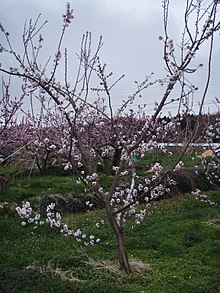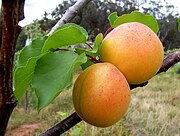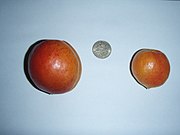In culture[edit]
The apricot is the national fruit of Armenia, mostly growing in the Ararat plain.[30][31] It is often depicted on souvenirs.[32]
The Chinese associate the apricot with education and medicine. For instance, the classical word 杏 壇 (literally: "apricot altar") (xìng tán 杏坛) which means "educational circle", is still widely used in written language. Chuang Tzu, a Chinese philosopher in the fourth century BC, told a story that Confucius taught his students in a forum surrounded by the wood of apricot trees.[33] The association with medicine in turn comes from the common use of apricot kernels as a component in traditional Chinese medicine, and from the story of Dong Feng (董奉), a physician during the Three Kingdoms period, who required no payment from his patients except that they plant apricot trees in his orchard upon recovering from their illnesses, resulting in a large grove of apricot trees and a steady supply of medicinal ingredients.[34] The term "expert of the apricot grove" (杏林高手) is still used as a poetic reference to physicians.[citation needed]
杏(學名:Prunus armeniaca),其果又稱杏子、杏實、杏桃,是李屬李亞屬植物,其果肉、果仁均可食用。
起源[編輯]
歐洲的杏是從亞美尼亞引進的[3],因此杏的學名種加詞是亞美尼亞。但群體遺傳學研究表明杏起源於中亞,在中亞和中國發生至少三次獨立的馴化事件,而後傳入其它地區。[4][5]
形態特徵[編輯]
落葉喬木,高8-12公尺(26-39英尺),樹幹直徑約40公分(16英寸)。闊卵形或圓卵形葉子,邊緣有鈍鋸齒,長5-9公分(2.0-3.5英寸),寬4-8公分(1.6-3.1英寸)。近葉柄頂端有二腺體;淡紅色花單生或2-3個同生;圓、長圓或扁圓形核果,果皮多為金黃色,向陽部有紅暈和斑點;暗黃色果肉,味甜多汁;核面平滑沒有斑孔,核緣厚而有溝紋。[6][7]
栽培與使用[編輯]
中醫認為杏有潤肺定喘、生津止渴之用。民諺云:「端午吃個杏,到老沒有病」。但又忌諱多吃,有「桃養人、杏傷人、李子樹下埋死人」之說。《日華子本草》認為杏「熱,有毒」。《本草衍義》也說:「小兒尤不可食,多食致瘡癰及上膈熱」。[8]
文化[編輯]
相傳三國時東吳有位名醫叫董奉,精通醫道,有妙手回春之術,醫德也高。他晚年為百姓治病不收診費和藥錢,但要求病人痊癒後必須到山上種植杏樹,名為「康樂杏」。後來,杏林用來專指醫術精良,醫德高尚的醫生。[9]
杏仁這名稱常常因為地域不同,而有不一樣的植物對應。台灣的杏仁與中國的杏仁,所指的乾果類似但不相同。台灣的杏仁,所指的是一種Almond乾果。廣泛用於烘培,零食,化妝品基底油等等。是一種非常健康,幾乎沒有副作用的乾果。
中國大陸所謂的「杏仁」(英語:apricot kernel),則是指杏、山杏或東北杏的種子(果仁),可以食用或入藥。原產於東亞和中亞。
一般常吃到的零嘴「杏仁」烘培原料,化妝品基底油 或「杏仁乾果」是另一種"杏"Almond的種仁,中國稱為扁桃(英語:Almond)的種子扁桃仁。[1][2]
苦杏仁與甜杏仁[編輯]
有苦杏仁(Prunus armeniaca Linne var. ansu Maximowicz)與甜杏仁(Prunus armeniaca L.)之別。
在中國廣東地區有南杏北杏的叫法,在香港統稱南北杏,一般甜杏仁稱南杏,苦杏仁稱北杏。香港的中藥材店會以比例出售:大部分是南杏,加少量北杏。
甜者供食用,苦者供藥用,苦杏仁呈心臟形略扁,左右不對稱,種皮紅棕色或暗棕色,味苦,在中國主要分布在華南、華北、西北各地。甜杏仁形略大,左右對稱,種皮淡棕色至暗棕色,微甜而不苦,在中國主要分布於華中、華北、西南各地。苦杏仁較有止咳化痰的作用,尤其針對體虛而受寒的咳嗽症狀,特別有效。值得注意的是,未經處理的杏仁,特別是苦杏仁有苦杏仁苷,水解會釋放出氰化氫,可阻斷細胞呼吸鏈,妨礙三磷酸腺苷產生[3];也正因此少量苦杏仁能起到抑制神經中樞、止咳平喘等作用,但需依醫師指示服用,過量食用可能會導致氰化氫中毒[4]。
杏仁(きょうにん、あんにん[注釈 1])は、アンズの種子の中にある仁(さね)を取り出したもの。長さは1.1-1.5mmで、形状は扁平の先の尖った卵円形である[1]。基部は左右対称ではない[1]。
漢方[編集]
古くからバラ科植物の仁は生薬や食用に利用され、杏仁(アンズ)のほか、桃仁(モモ)、梅仁(ウメ)、アーモンドなどがある[2]。
杏仁には苦みの強い苦杏仁(くきょうにん、Prunus maximowiczii)と、甘みのある甜杏仁(てんきょうにん)があり、前者は薬用に、後者は杏仁豆腐(あんにんどうふ)やアマレットなどの材料として用いられている。ここでは生薬としての杏仁について説明する。
杏仁は、三国時代(3世紀)頃に編纂されたもっとも古い漢方薬書である『傷寒論』にあり、麻黄湯、大青竜湯などの重要な処方に配剤されている大切な薬味である。
古くから「毒のある薬味」とされており、処方する際には分量を慎重に決めるものとされていた。現代においては、分解されると青酸を発生するアミグダリンが含まれていることが判っている。
漢方では鎮咳剤として多く用いられている[1]。
なおバラ科植物の仁の区別は、アーモンドなどを除ききわめて難解である[2]。『本草辨疑』には桃仁は見分けやすいが、杏仁と梅仁はよく似ているため、杏仁と梅仁が混じって売られていることがあると記されている[3]。現実の生薬市場では、『本草辨疑』で見分けやすいとされている桃仁にも杏仁が混入している場合がある[1]。
An apricot kernel is the apricot seed located within the fruit endocarp, which forms a hard shell around the seed called the pyrena (stone or pit).[1][2]
The kernel contains amygdalin, a poisonous compound, in concentrations that vary between cultivars. Together with the related synthetic compound laetrile, amygdalin has been marketed as an alternative cancer treatment. However, studies have found the compounds to be ineffective for treating cancer.[3]
Use[edit]
The kernel is an economically significant byproduct of fruit processing and the extracted oil and resulting press cake have value.[4] Apricot kernel oil gives Disaronno and some other types of amaretto their almond-like flavor.[5]
Potential toxicity[edit]
Apricot kernels can cause potentially fatal cyanide poisoning when consumed. Symptoms include nausea, fever, headaches, insomnia, increased thirst, lethargy, nervousness, various aches and pains in joints and muscles, and a drop in blood pressure.[6][7][8]
In 2016, the European Food Safety Authority reported that eating three small bitter apricot kernels or half of a large bitter kernel would exceed safe consumption levels of amygdalin and potentially cause cyanide poisoning.[9] The Food Safety Authority of Ireland advises against eating either bitter or sweet varieties of apricot kernel due to the risk of cyanide poisoning and advises consumption be limited to one to two kernels a day for an adult. They also advise against consuming bitter almond for the same reasons.[10]
In 1993, the New York State Department of Agriculture and Markets tested the cyanide content of two 220 gram (8 oz) packages of bitter apricot kernels imported from Pakistan that were being sold in health-food stores as a snack. The results showed that each package, if consumed entirely, contained at least double the minimum lethal dosage of cyanide for an adult human; the product was removed from stores.[11] There was one reported case in the medical literature of cyanide toxicity from apricot kernels from 1979 to 1998 in the United States, a non-fatal poisoning by purchased apricot kernels.[12]
アンズ
| アンズ | ||||||||||||||||||||||||
|---|---|---|---|---|---|---|---|---|---|---|---|---|---|---|---|---|---|---|---|---|---|---|---|---|
 アンズの果実 | ||||||||||||||||||||||||
| 分類 | ||||||||||||||||||||||||
| ||||||||||||||||||||||||
| 学名 | ||||||||||||||||||||||||
| Prunus armeniaca L. (1753) 標準[1] Prunus armeniaca L. var. ansu Maxim. (1883) 狭義[2] | ||||||||||||||||||||||||
| シノニム | ||||||||||||||||||||||||
| 和名 | ||||||||||||||||||||||||
| アンズ(杏子/杏) | ||||||||||||||||||||||||
| 英名 | ||||||||||||||||||||||||
| Apricot |
アンズ(杏子・杏[7]、学名: Prunus armeniaca)は、バラ科サクラ属の落葉小高木である。アプリコットと英名で呼ばれることもある。別名、カラモモ(唐桃)。中国北部で形成された東洋系の品種群には、ウメとの交雑の痕跡がある。原産地は諸説あるものの、中国の山東省、河北省の山岳地帯から中国東北地方の南部とする説が有力とされる[8]。学名のPrunus armeniaca は、ヨーロッパにおいては近世にいたるまでアルメニア (Armenia) が原産地と考えられていたためつけられたもの(『産地』節も参照)[8]。
名称[編集]
和名アンズは、杏子の唐音とされている[9]。古名は、カラモモである[8][10][11][12][13][14]。中国植物名は杏(きょう)[15]。
中国大陸から日本への渡来は古く、日本最古の本草書『本草和名』(918年)には、漢字を「杏子」、和名「カラモモ」とある[16]。標準和名アンズの読みは、江戸時代になってから、漢名の杏子を唐音読みでアンズとなったといわれている[16]。
特徴[編集]
中国の北東部[17]、山東省、河北省、山西省、黄河より北の原産といわれる[16]。日本では、長野県、山梨県、山形県を中心に栽培されている[15][16]。
落葉広葉樹の小高木[15]。開花期は春(3 - 4月頃)[17]。桜よりもやや早く、葉に先立って淡紅色の花を咲かせる[17]。花は一重咲きのほか、八重咲きの品種もある[17]。葉は卵円形で葉縁には鋸歯がある[17]。
花は美しいため花見の対象となることもある。自家受粉では品質の良い結実をしないために、他品種の混植が必要であり、時には人工授粉も行われることがある。6 - 7月には収穫期を迎え、ウメによく似た果実は橙黄色に熟し、果肉は赤みを帯びて核と離れやすくなる[16]。果実の表面には、細かな産毛が密生する[17]。
アーモンドやウメ、スモモと近く、容易に交雑する。ただし、ウメの果実は完熟しても果肉に甘みを生じず、種と果肉が離れないのに対し、アンズは熟すと甘みが生じ、種と果肉が離れる(離核性)。またアーモンドの果肉は、薄いため食用にしない。耐寒性があり比較的涼しい地域で栽培されている。












沒有留言:
張貼留言